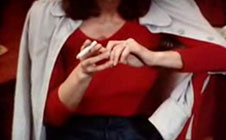|
|
|
|
Behindert
|
 |
|
Stephen
Dwoskin may be recognised more for what has been written about him – such as an
influential 1976 Afterimage essay by
Paul Willemen on the “fourth look” in cinema, theorised from a careful viewing
of Dyn Amo (1972) – than for his own
prodigious work. Dwoskin’s career began in
the Warhol Factory early ‘60s and continued unabated for over five decades – despite the near-death experience which is
recorded, with typically paradoxical voluptuousness, in Intoxicated by My Illness (2001). Hailing from America and based mainly in Britain, Dwoskin, like those
similarly magpie filmmakers whose paths he has crossed (Robert Kramer, Boris
Lehman, Philippe Grandrieux, Raśl Ruiz), took advantage of production
opportunities all over Europe, bending all manner of commissions (collaborating
with a dance company, documenting the work of photographer Bill Brandt, filling
an experimental television slot for “hour-long single takes”) to his own
artistic will – gradually exchanging 16 millimetre for digital video along the
way. He was a fundamentally “stateless” artist.
Willemen
– like other prominent critics who, each from very different perspectives,
championed their friend Dwoskin, such as Raymond Durgnat and Laura Mulvey – was
right to zero in on the look or gaze as constitutive of Dwoskin’s cinema. What characterises
his work, above all, is the irrefutable, hypersensitive, always volatile
presence of the filmmaker’s camera-eye: searching, curious, hungry for all the
world’s surfaces, human or otherwise. There is nothing disembodied about this
gaze: its height, its point in space, its formidable grappling with lens and
focus, frequently returns us to Dwoskin’s position in a bed, wheelchair, or on
the floor. His films often foreground the experience of his disability – he was
stricken with polio in early childhood. François Albera compares Dwoskin’s body
with a camera tripod – a hulking, difficult-to-manage contraption – thus
squaring this camera-eye with the cinematic apparatus itself. But there is
something more to Dwoskin’s camerawork, and it goes far beyond even the most
elaborate theory of the voyeuristic-fetishistic gaze. In his most agonisingly
poignant films, like Dear Frances, Dad, and Lost Dreams (all from 2003), Dwoskin’s images register not ocular
possession but loss, distance, the fundamental otherness of all the beings who
flicker past his camera and through his life.
Behindert (1974) was a
revelation for me – an astonishingly intimate recreation of Dwoskin’s time with
actor Carola Regnier, who gives a hypnotically intricate performance of her own
desires and vulnerabilities. This is Dwoskin’s masterpiece – indeed, I have
come to regard it as the one of the greatest works in cinema history. Once
again, it is structured in tableaux, almost classically so – from first glance
to final parting, it is like the Stations of the Cross of a modern
relationship; and is it accidental that it comes only a year after Bergman’s Scenes from a Marriage (1973)? Like many
of Dwoskin’s pieces, it is a reflection upon his physical condition – the title
could be translated as hindered or even handicapped, hence disabled – and the
strains it poses on his exchanges with an able-bodied lover. But this is as far
from a social problem or disease-of-the-week telemovie as can possibly be
imagined – as the perfectly judged long takes, coupled with the relentless
drone-score of Gavin Bryars, attest.
Behindert remains Dwoskin’s
most daring and artistically successful attempt to splice his first-person mode
of cinema with a staged fiction – creating a kind of cubistic complexity from
the constantly shuffled perspectives. The fourth look that Willemen intuited –
not exactly the look of the characters, the spectator or even the camera-eye,
but some other, more forbidding look, like the gaze of society itself – hovers
over the interstices between these images, these tableaux, these scenes from a
relationship. From a film history standpoint, Dwoskin’s breakthrough here is
prophetic: anticipating the ongoing novelistic autobiography of Philippe
Garrel’s work since L'Enfant secret (1982), Behindert plays a thrilling, almost vampiric game with the
proximity of real-life experience to its fictive recreation – especially as its
principals are the actual former lovers!
It
is easy to bemoan the lack of attention which Dwoskin’s prodigious work has so
far received within the institutions of international film culture – and to
wonder why he is not routinely put up alongside Stan Brakhage, Michael Snow, Hollis
Frampton, Yvonne Rainer and all the rest in the long-established Mount Rushmore
of avant-garde cinema – a ranking all too frequently skewed to USA interests.
Dwoskin himself seemed to view his precarious (and sometimes invisible) place
in the pantheon in a different, altogether positive spirit, with nothing of
what would be an understandable ressentiment.
Perhaps (as he reflected in 1981) the conventional cinema arrangement of a mass
audience before a screen in a darkened hall was never really well suited to his
work, which “aims to take the viewer one by one”, in contradistinction to
Hollywood which “aims to amalgamate the audience”. The new era of one-by-one or small group
viewing with computers and DVD is one that Dwoskin’s brand of hyper-personal
cinema, in this sense, always awaited; but in this context of home consumption,
it will surely be a deliciously subversive counterspectacle.
MORE Dwoskin: I’ll Be Your Eyes, You’ll Be Mine, Trying to Kiss the Moon, Oblivion, Outside In © Adrian Martin July 2007 |
![]()